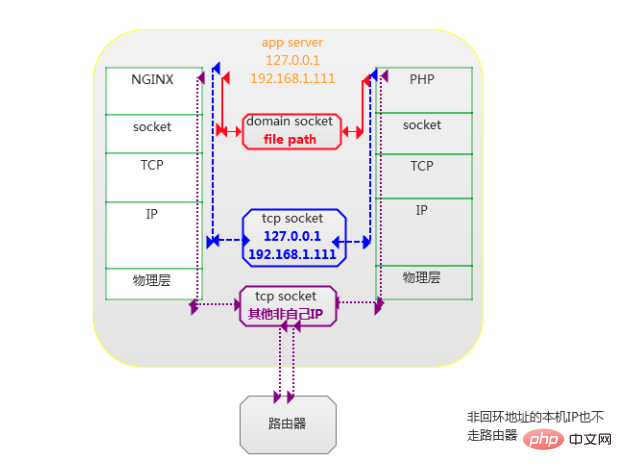

[Related learning recommendations:php graphic tutorial]
The code files of each dynamic language (PHP, Python, etc.) need to pass the corresponding parser before they can be Server identification, and the CGI protocol is used to enable the interpreter and server to communicate with each other. The parsing of PHP files on the server requires the use of a PHP interpreter, coupled with the corresponding CGI protocol, so that the server can parse PHP files.
Since the mechanism of CGI requires forking a CGI process for each request, and then killing the process after the request is completed, which is a waste of resources in practical applications, so an improved version of CGI, FastCGI, appeared. After processing, the process will not be killed, but multiple requests will continue to be processed, which greatly improves efficiency.
PHP-FPM is PHP-FastCGI Process Manager. It is the implementation of FastCGI and provides process management functions. The process includes two types: master process and worker process; there is only one master process, which is responsible for listening to the port and receiving requests from the server, while there are generally multiple worker processes (the specific number is configured according to actual needs), and each process will have one embedded in it. The PHP interpreter is where the code is actually executed.
When we visit a website (such as www.test.com), the processing flow is like this:
www.test.com | | Nginx | | 路由到 www.test.com/index.php | | 加载 nginx 的 fast-cgi 模块 | | fast-cgi 监听 127.0.0.1:9000 地址 | | www.test.com/index.php 请求到达 127.0.0.1:9000 | | 等待处理...
[Related article recommendations:Nginx tutorial]
On Linux, the communication between nginx and php-fpm has tcp There are two ways: socket and unix socket.
The advantage of tcp socket is that it can cross servers. This method can only be used when nginx and php-fpm are not on the same machine.
Unix socket is also called IPC (inter-process communication) socket, which is used to implement inter-process communication on the same host. This method requires filling in the socket file location of php-fpm in the nginx configuration file. .
The data transmission process of the two methods is shown in the figure below:
The difference between the two:
Because Unix socket does not need to go through the network protocol stack , there is no need to pack and unpack, calculate checksums, maintain sequence numbers and responses, etc. It just copies application layer data from one process to another. Therefore, its efficiency is higher than that of tcp socket, which can reduce unnecessary tcp overhead. However, unix sockets are unstable when concurrency is high. When the number of connections explodes, a large number of long-term caches will be generated. Without the support of a connection-oriented protocol, large data packets may directly go wrong without returning an exception. Connection-oriented protocols such as tcp can better ensure the correctness and integrity of communication.
The combination of Nginx and php-fpm only requires settings in their respective configuration files:
1) Configuration in Nginx
Take tcp socket communication as an example
server { listen 80; #监听 80 端口,接收http请求 server_name www.test.com; #就是网站地址 root /usr/local/etc/nginx/www/huxintong_admin; # 准备存放代码工程的路径 #路由到网站根目录 www.test.com 时候的处理 location / { index index.php; #跳转到 www.test.com/index.php autoindex on; } #当请求网站下 php 文件的时候,反向代理到 php-fpm location ~ \.php$ { include /usr/local/etc/nginx/fastcgi.conf; #加载 nginx 的 fastcgi 模块 fastcgi_intercept_errors on; fastcgi_pass 127.0.0.1:9000; # tcp 方式,php-fpm 监听的 IP 地址和端口 # fasrcgi_pass /usr/run/php-fpm.sock # unix socket 连接方式 } }
2) Configuration of php-fpm
listen = 127.0.0.1:9000 # 或者下面这样 listen = /var/run/php-fpm.sock
Note that when using unix socket to connect, since the socket file is essentially a file, there are permission control issues, so it is necessary Pay attention to the permissions of the nginx process and the permissions of php-fpm, otherwise you will be prompted to access without permission. (Set users in their respective configuration files)
The communication between php-fpm and nginx can be completed through the above configuration.
If nginx and php-fpm are running on the same server, and the concurrency is not high (no more than 1000), choose unix socket to improve nginx Communication efficiency with php-fpm.
If you are facing high concurrent business, consider using a more reliable tcp socket to maintain efficiency through operation and maintenance methods such as load balancing and kernel optimization.
If the concurrency is high but you still want to use unix socket, you can improve the stability of unix socket through the following methods.
1) Place the sock file in the /dev/shm directory. Place the sock file in the memory in this directory, so that the memory can be read and written faster.
2) Increase the backlog
Backlog default bit 128, 1024, this value is replaced by your normal QPS, the configuration is as follows.
nginx.conf file
server { listen 80 default backlog = 1024; }
php-fpm.conf file
listen.backlog = 1024
3) Add sock file and php-fpm instance
in/ Create a new sock file in dev/shm, load balance requests to two sock files through the upstream module in nginx, and map the two sock files to two sets of php-fpm instances.
The above is the detailed content of Summary of the communication mechanism between PHP-FPM and Nginx. For more information, please follow other related articles on the PHP Chinese website!
 nginx restart
nginx restart Detailed explanation of nginx configuration
Detailed explanation of nginx configuration Detailed explanation of nginx configuration
Detailed explanation of nginx configuration What are the differences between tomcat and nginx
What are the differences between tomcat and nginx Windows cannot connect to wifi solution
Windows cannot connect to wifi solution How to export excel files from Kingsoft Documents
How to export excel files from Kingsoft Documents Common encryption methods for data encryption storage
Common encryption methods for data encryption storage What are private clouds?
What are private clouds?